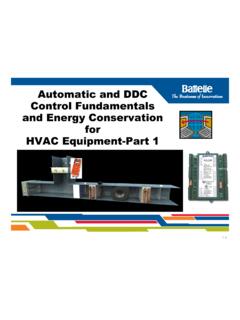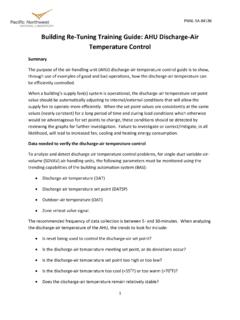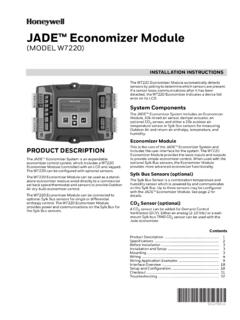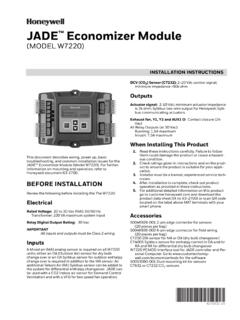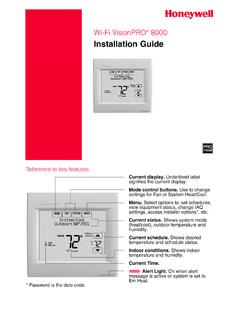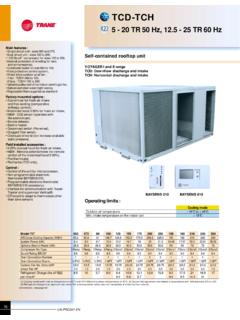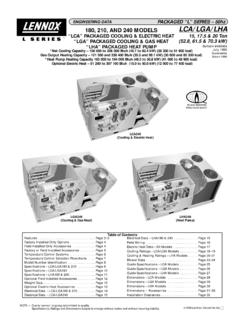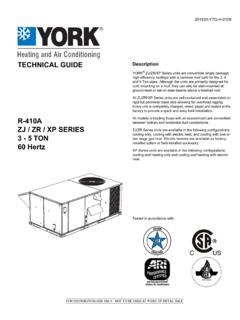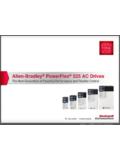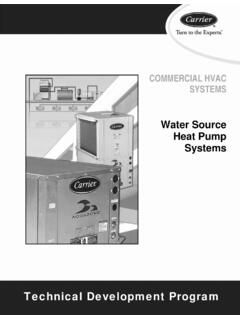Transcription of HVAC Economizers 101 Section #5 Typical Economizer ...
1 HVAC Economizers 101 Section #5 Section #5 Typical Economizer Controls on Rooftop Units Rooftop Units that Utilize Honeywell Controls5-1 Section #5- Typical Economizer Controls on Rooftop Units Utilizing Controls on Rooftop Units Utilizing Honeywell ControlsD(th) Dampers (not shown) Damper actuator MAT/DAT sensors Solid state controller OAT/RAT sensorsActuator M7414 Temperature Sensor C7046C Dry bulb EnthalpyController W7212 Enthalpy Sensor C7400A5-2(Honeywell shown, often basis of OEM RTU brands, out there for 20+ years)Source: Honeywell ControlsHoneywell W7459 Economizer and Associated Control ComponentsAssociated Control Components5-3 Basic Economizer Cycle Sequence Typical for Honeywell with only 1 stg. CoolingTypical for Honeywell with only 1 stg.
2 Cooling(For Typical packaged RTU with DX mechanical cooling)On a First Call for Cooling From Commercial Thermostat (Y1) Controller signal is routed to the Economizer logic THE OUTDOOR AIR IS SUITABLE FOR FREE COOLINGIF THE OUTDOOR AIR IS SUITABLE FOR FREE COOLING: Actuator modulates the outdoor damper open until the room temperature is cool enough to satisfy the call for cooling and maintain the desired set point When the mixed or discharge air is between 50 and 55 Fthepoint. When the mixed or discharge air is between 50 and 55 F, the actuator will hold the damper position. When the mixed or supply air goes below 50 F, the damper is modulated towards closed. When the mixed or supply air goes above 56 F, the damper is modulated towards ygppIF THE OUTDOOR AIR IS NOT SUITABLE FOR FREE COOLING.
3 The first stage of the cooling compressor is turned on and the dampers are set to minimum for occupancy requirements5-4are set to minimum for occupancy Economizer Cycle Sequence Typical for Honeywell with one stage CoolingTypical for Honeywell with one stage Cooling(For Typical packaged RTU with DX mechanical cooling)5-5 Economizer Control Diagram for One Stage Coolinggg5-6 Basic Economizer Cycle Sequence Typical for Honeywell With Two Typical for Honeywell With Two Stage Cooling with EconomizerOn a Call for Single Stage CoolingOn a Call for Single Stage Cooling Controller signal is routed to the Economizer logic module to maintain space temperature using outside air for free a Call for Second Stage CoolingOn a Call for Second Stage Cooling If the outdoor air is suitable for free cooling and the outside are dampers are open,The Economizer logic turns on the first stage of mechanical cooling for the second stage of cooling required by the commercial thermostat.
4 If the outdoor air is not suitable for free cooling,The dampers are set to minimum for occupancy requirements, the first stage cooling compressor is on, and the logic module turns on the second stage of mechanical cooling if available. NOTEA ilthttithiifttflii NOTE: A commercial thermostat with a minimum of two stages of cooling is required. The first stage must be available for economizing if outside air is Operation of Honeywell Thermostat and Controls for Two Stage gCooling with Outside Air Economizer5-8 Source: Honeywell ControlsEconomizer Control Diagram for Two Stage Coolinggg5-9 Troubleshooting Factory Schematics Requires Identifying Sensors, Thermostats, equ es de t y g Se so s,eostats,Controllers, Relays, and ActuatorsControllerSensorActuatorThermos tat5-10 Source.
5 Honeywell ControlsCooling RelaysECONOMIZER INFORMATION(For completion by Service Technician) Economizer Checkout Sheet (sample) Economizer INFORMATION (For completion by Service Technician)Sensor Ty p e(EM or SS/Where PlacedAs found conditions (temp and RH (ifOutput(DC Volts, mA, k -- enter td dAdjusted outputCleaned?Rl d?SS/DB or, h)*RH (if enthalpy))expected and actual values)BookActualReplaced?Enter C or ROutside AirMixed Air TempDischarge Air TempReturnReturn* EM=electromechanical, SS=solid state, DB= dry bulb, h=enthalpy (total energy)Control LogicAs Found ____Changeover ( A, B, C, D, DIP settings, Snap Disk) T if DIP_____(check choices & circle settings. If DIPs, convert to temperature (if known). For differentialrecord as-____ Differential (outside & return air sensors wired) POT _____ Final ____Changeover ( A, B, C, D, DIP settings, Snap Disk) T if DIP_____ Differential (outside & return air sensors wired) POT _____ 5-11differential, record asfound changeover POT setting.))
6 Change if not on D.)Source: PSEE conomizer Checkout Results(Summarize repairs and replacements)(Summarize repairs and replacements)Upon your arrival, was Economizer fully functional? If not, briefly describe problem(s):Yes____ No____Sensor output was checked (enter values above)Yes____ No____The outside air damper moves to full open without catching or bindingYes____ No____binding The outside air damper moves to minimum setting without catching or binding Yes____ No____Type of relief air:barometric dampermechanicallypowered exhaustType of relief air: ___ barometric damper ___ mechanicallypowered exhaust ___ none Controller operation was checkedYes____ No____Economizer changeover was adjusted to match climateYe sNoEconomizer changeover was adjusted to match climate conditions at A, B, C, or D ?
7 If not, explain why not:Ye s____No____Should demand controlled ventilation (DCV) be added?Ye sNo5-12 Should demand controlled ventilation (DCV) be added?Ye s____No____If (DCV) was added, was min. air set to 5% of system flow?Yes____ No____Honeywell W7459 Checkout and Setup Proceduresp Verify all sensors are reading correctly. (See next 3 slides for more details on sensor checkout.) Generate a call for cooling. Adjust A-B-C-D setting to D (Humid Climates) For changeover control Economizer should be disabled For changeover control, Economizer should be disabled and outside air damper at minimum if outside air conditions are greater than 55 F (dry bulb) or between 20 and 22 Btu/lb (enthalpy). Adjust A-B-C-D setting to A (Dry Climates) For changeover control, Economizer should be enabled and outside air damper modulate full open if outside air ditilth85 F(d b lb)b t23conditions are less than 85 F (dry bulb) or between 23 and 32 Btu/lb (enthalpy).
8 For differential control strategy, Economizer will only be enabled when outside air temperature is5-13only be enabled when outside air temperature is less than return W7459 Sensor Signal and Checkout Analog temperature sensors typically: Produce a milliamp or resistance signal; check with a DMM in mA ( h) St lidor (ohms). See next slide. Measure sensor output and current temperature and compare each value with manufacturer s published data; checked with a DMM in (ohms) at a known temperature. Thermostats simply change state at specific temperaturesCompare existing temperature to point when thermostat changes Compare existing temperature to point when thermostat changes state; checked with a DMM in continuity mode, as a switch h ttl Snap Discs change state only They cannot be adjusted or verified with any degree of accuracy.
9 They typically change state between 60 F and 65 Fwhichisa5-14 They typically change state between 60F and 65F, which is a fixed setting at the factory; checked with a DMM in continuity mode, as a switch closure at design C7150 and C7046 Analog Temperature Sensor Checkout Chart (ohms/ F)p()5-15 Honeywell Temperature Sensor C7650 Checkout Chart (mA/ F)Checkout Chart (mA/F)5-16 The W7459 is used in conjunction with a Honeywell actuator (M7415) and sensors to control outdoor andactuator (M7415) and sensors to control outdoor and return air dampers free cooling using outside air. It is designed to be installed directly on the W7459 Economizer Control5-18W7459 Enthalpy Economizer Control Settings = A,B,C, or Dg,,,5-19 Adjusting Minimum Damper Positionfor Honeywell W7459Ay Note: The W7459A uses inputs from mixed or discharge air temperature sensors.
10 Minimum Position Adjustment - Minimum position potentiometer keeps outdoor air damper from closing completely during system operation to provide mixed air sensor from terminals T and sure either factory-installed jumper is in place across terminals P and P1 or if remote damper positioneris required, that it is ppqwired according to Honeywell instructions and turned fully clockwise. See Figure on next 24 Vac across terminals TR and potentiometer on face of W7459A with screwdriver to desired minimum : Check actual percentage of OSA by utilizing % charts : Check actual percentage of OSA by utilizing % charts or formulas, discussed W7459A5-21 Honeywell W7459A5-22 Adjusting Minimum Damper Positionfor Honeywell W7459By Note: The W7459B is designed for use with a W7401 Logic Panel or a Honeywell Legacy direct digital sure either the factory-installed jumper is in place across terminals P and P1 or if remote damper positioner is required, it is wired according toHoneywell instructions,and turned fullyis wired according to Honeywell instructions, and turned fully clockwise.

